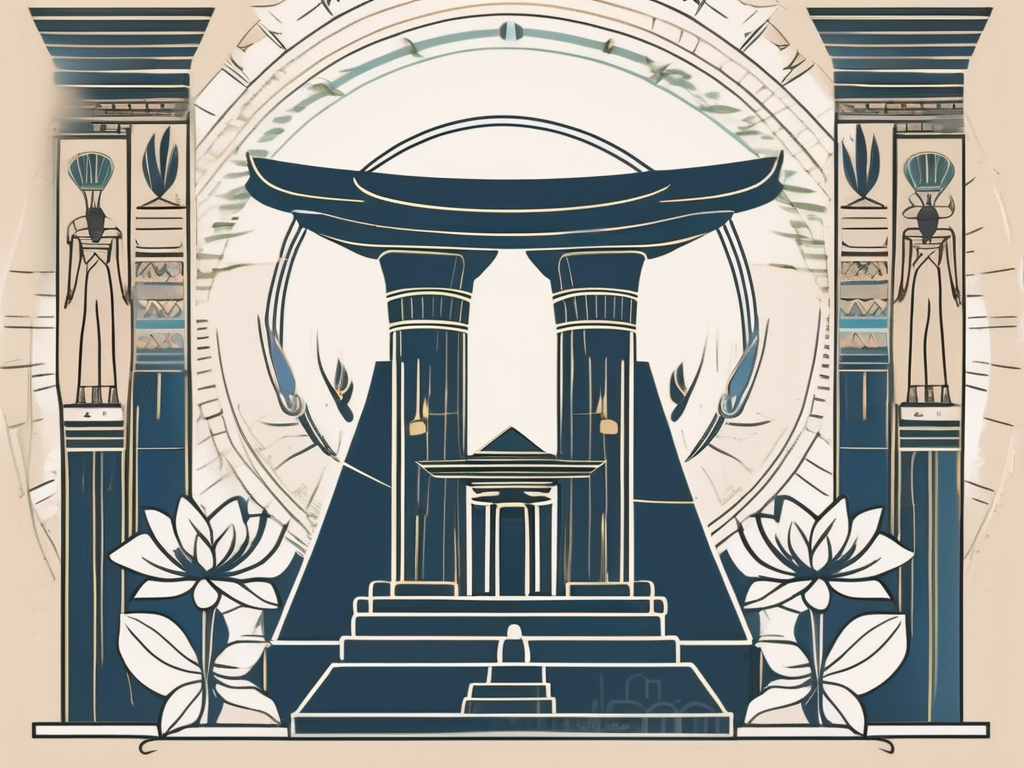Welcome to the fascinating world of ancient Egyptian mythology, where gods and goddesses reign supreme. In this article, we will be delving deep into the mysterious deity known as Nephthys. Join us as we uncover the secrets surrounding this enigmatic Egyptian god.
Understanding the Role of Nephthys in Egyptian Mythology
When exploring Nephthys, it is crucial to grasp her significance within the vast pantheon of Egyptian gods. She is often regarded as the sister of the famous goddess Isis and the wife of Seth, thus making her a pivotal figure in the intricate web of family relations.
It is believed that Nephthys emerged during the dawn of Egyptian civilization. Her origins can be traced back to the ancient Egyptian creation myth, where she played a fundamental role along with her sibling deities.
The Origins of Nephthys
In Egyptian mythology, Nephthys is said to be the daughter of Geb, the earth god, and Nut, the sky goddess. She was born alongside her brothers, Osiris, Seth, and Horus, during the formation of the universe itself. This divine birthright bestowed upon her immense power and influence within the Egyptian pantheon.
As the daughter of Geb and Nut, Nephthys inherited the qualities of both earth and sky. She embodied the duality of the natural world, representing the balance between the physical and the spiritual realms. This unique combination of elements made her a symbol of harmony and equilibrium.
Furthermore, Nephthys was known for her exceptional beauty. Her radiant presence illuminated the heavens, captivating both gods and mortals alike. Her enchanting aura was said to bring solace and serenity to those who encountered her.
Nephthys in the Pantheon of Gods
Despite not being as widely known as some of her divine relatives, Nephthys occupied a unique position within the Egyptian pantheon. She was revered as the protector of the dead and the mistress of the underworld. Her role in the afterlife and her connection to funerary rituals made her an object of great importance to the ancient Egyptians.
When a person passed away, it was believed that Nephthys would guide their soul through the treacherous journey into the afterlife. She would accompany them on their path, providing comfort and protection along the way. Her presence was seen as a beacon of hope amidst the darkness of the underworld.
Additionally, Nephthys played a crucial role in the judgment of souls. She would assist Osiris, the god of the afterlife, in weighing the hearts of the deceased against the feather of Ma’at, the goddess of truth and justice. This solemn task ensured that only those who lived virtuous lives would be granted eternal peace in the realm of the gods.
Furthermore, Nephthys was associated with the annual flooding of the Nile River, which was a vital event in ancient Egyptian agriculture. Her connection to the river symbolized fertility and abundance, as the floodwaters brought life-giving nutrients to the surrounding land. She was revered as a benevolent goddess, bestowing prosperity and sustenance upon the people.
In conclusion, Nephthys, the sister of Isis and the wife of Seth, played a significant role in Egyptian mythology. Her origins as the daughter of Geb and Nut, her embodiment of the earth and sky, and her association with the afterlife and the Nile River all contributed to her importance within the pantheon of gods. Understanding Nephthys allows us to delve deeper into the rich tapestry of Egyptian mythology and appreciate the intricate beliefs and rituals of this ancient civilization.
The Symbolism and Iconography of Nephthys
Visual depictions of Nephthys in ancient Egyptian art provide us with valuable insights into her symbolism and iconography. These representations allow us to gain a deeper understanding of her role and significance in the ancient Egyptian belief system.
Nephthys, the sister of Isis and Osiris, played a crucial role in Egyptian mythology. She was often depicted as a slender and elegant goddess, radiating an aura of mystery and power. Ancient Egyptian artists skillfully captured her essence, portraying her with great attention to detail.
Depictions of Nephthys in Ancient Art
Ancient Egyptian artists portrayed Nephthys as a slender and elegant goddess, often wearing a headdress resembling the hieroglyphic symbol of her name. This headdress consisted of a basket with two tall plumes, evoking the image of a nurturing and protective figure.
The headdress worn by Nephthys was not merely a decorative accessory; it held deep symbolic meaning. The basket represented her role as a provider and nurturer, symbolizing the sustenance she offered to both the living and the deceased. The two tall plumes, on the other hand, represented her connection to the heavens, signifying her ability to bridge the gap between the mortal realm and the divine.
Additionally, Nephthys was sometimes depicted with outstretched wings, symbolizing her role as a guardian and protector of the deceased. These artistic representations reinforced her association with the afterlife and emphasized her ability to guide souls on their journey to the realm of the gods.
The artists’ attention to detail extended beyond Nephthys’ physical appearance. They skillfully captured her enigmatic nature through subtle nuances in her facial expression and posture. The slight tilt of her head and the serene yet determined look in her eyes conveyed a sense of wisdom and authority, reflecting her role as a powerful goddess in the Egyptian pantheon.
The Sacred Symbols Associated with Nephthys
Several sacred symbols are associated with Nephthys, which further highlight her importance in the ancient Egyptian belief system. One such symbol is the mourning dove, representing her role as a goddess of lamentation and mourning.
The mourning dove, known for its mournful cooing, was believed to be a messenger between the mortal realm and the afterlife. Its presence in depictions of Nephthys served as a reminder of her ability to console and guide those who mourned the loss of their loved ones. The mournful sound of the dove’s call echoed the grief felt by those left behind, and Nephthys, in her compassionate nature, offered solace and comfort.
Another symbol often linked to Nephthys is the hieroglyphic depiction of her name. This symbol represents the basket used for bread-making, showcasing her nurturing and protective qualities. The significance of these symbols cannot be overstated, as they provide valuable clues about the mysteries surrounding Nephthys.
The hieroglyphic symbol of Nephthys’ name not only represented the physical object of a bread-making basket but also carried deeper connotations. Bread, a staple food in ancient Egypt, symbolized sustenance and nourishment. By associating Nephthys with the bread-making basket, the ancient Egyptians acknowledged her role as a provider and protector, ensuring the well-being and prosperity of both the living and the deceased.
Furthermore, the basket symbolized the cyclical nature of life and death. Just as bread is made from the grains of harvested crops, Nephthys oversaw the journey of souls from the mortal realm to the afterlife, guiding them through the cycles of existence.
In conclusion, the visual depictions of Nephthys in ancient Egyptian art reveal a goddess of profound significance and complexity. Through her portrayal as a slender and elegant figure, adorned with a headdress and wings, Nephthys embodied the nurturing and protective qualities associated with her. The sacred symbols linked to her, such as the mourning dove and the hieroglyphic depiction of her name, further emphasized her role as a goddess of lamentation, mourning, and sustenance. The artistry and symbolism surrounding Nephthys provide us with a glimpse into the rich mythology and belief system of ancient Egypt.
Nephthys and the Afterlife
One of the most fascinating aspects of Nephthys’ role in Egyptian mythology lies in her deep connection to the afterlife. Ancient Egyptians believed in an elaborate journey of the soul after death, and Nephthys played a crucial part in guiding and protecting the deceased on this spiritual voyage.
Nephthys’ Role in Funerary Rites
During funerary rites, Nephthys was invoked to ensure the safe passage of the deceased to the realm of the gods. Her nurturing and protective qualities made her an ideal guardian, as she watched over the souls with great care and compassion.
Moreover, Nephthys played a vital role in the ritual of Opening of the Mouth, a ceremony performed on the mummy to restore its senses and enable the deceased to partake in the afterlife. As such, she was an essential figure in the journey of the soul beyond the earthly realm.
Nephthys and the Journey of the Soul
Ancient Egyptians believed that the soul, represented by the ka, needed to pass through several stages before reaching the realm of the gods. Nephthys guided the soul through perilous terrains, protected it from malevolent beings, and ensured a safe arrival in the heavenly realms.
The journey of the soul was filled with trials and challenges, but it was ultimately Nephthys who provided solace and support, just as a devoted sister would. Her presence brought comfort and reassurance to the souls, allowing them to peacefully transition into the afterlife.
Nephthys in Literature and Texts
References to Nephthys can be found in various ancient Egyptian texts, shedding light on her significance within their culture. These textual sources offer a glimpse into the beliefs and practices surrounding this enigmatic goddess.
References to Nephthys in Ancient Egyptian Texts
One of the most notable mentions of Nephthys can be found in the ancient Egyptian funerary text known as the Book of the Dead. This sacred text served as a guide for the deceased on their journey to the afterlife, emphasizing the crucial role Nephthys played in ensuring a successful transition.
Other texts, such as the Pyramid Texts and the Coffin Texts, further emphasize Nephthys’ importance in the journey of the soul. These ancient writings provide invaluable insights into the spiritual beliefs and practices of the ancient Egyptians.
Nephthys in Modern Literature and Pop Culture
While Nephthys may not receive as much attention in modern literature and popular culture compared to her more renowned relatives like Isis and Osiris, she continues to captivate the imaginations of those delving into ancient Egyptian mythology.
Some contemporary authors have incorporated Nephthys into their works, drawing inspiration from her enigmatic nature and her connection to the mystical and unexplored realms of ancient Egypt. Through these modern reinterpretations, Nephthys finds a new audience eager to uncover her secrets.
The Worship and Cult of Nephthys
Throughout ancient Egypt, various temples and shrines were dedicated to the worship of Nephthys. These sacred sites were places of worship and pilgrimage, fostering a deep connection between the people and their beloved goddess.
Temples and Shrines Dedicated to Nephthys
One significant temple dedicated to Nephthys was the Temple of Hwt-Sekhem in Upper Egypt. It was within the sacred walls of this temple that devotees would pay their respects and seek the protection and guidance of the goddess.
Additionally, smaller shrines and sanctuaries were scattered across Egypt, allowing individuals to connect with Nephthys on a more personal and intimate level. These sacred spaces offered solace, inspiration, and a sense of belonging to those who sought the presence of this divine deity.
The Role of Nephthys in Ancient Egyptian Religion
Nephthys played a crucial role in the religious practices and beliefs of the ancient Egyptians. Her influence extended beyond the realms of the gods, permeating the daily lives of the people. As a goddess associated with protection, healing, and the afterlife, Nephthys provided comfort and hope to those who worshipped her.
Her enigmatic nature and her deep connection to the mysteries of life and death continue to captivate our imaginations and inspire us to explore the rich and vibrant world of ancient Egyptian mythology.
So, let us embark on this journey together, as we uncover the hidden truths of Nephthys and unravel the mysteries that surround this enigmatic Egyptian god.












